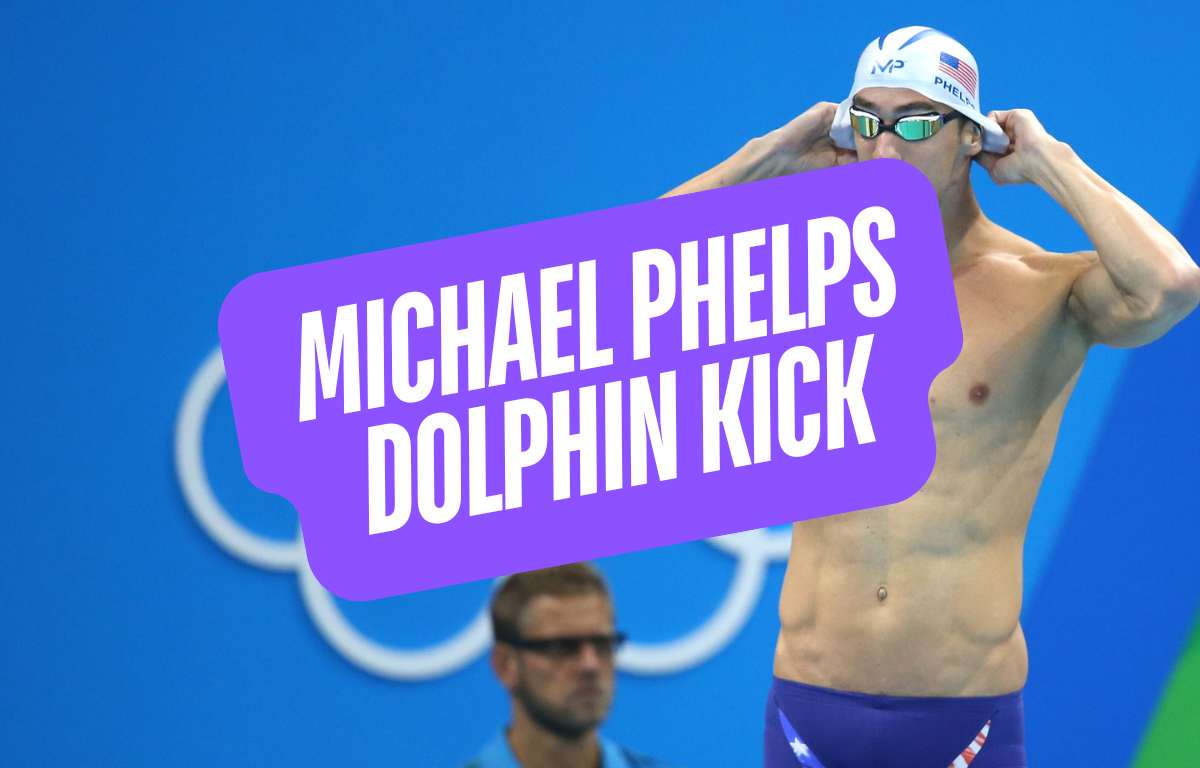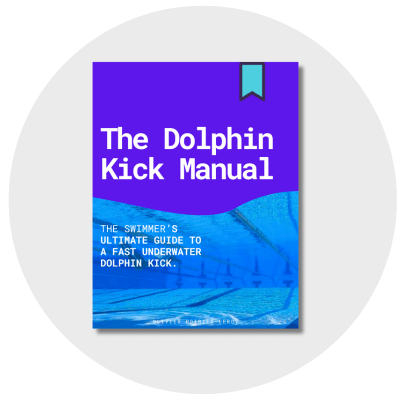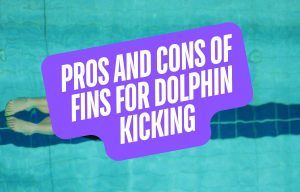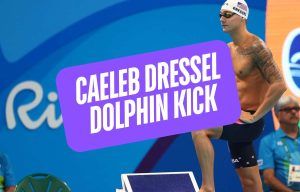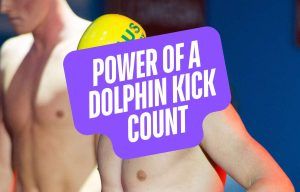Want faster underwaters? From undulation to breakout timing, here’s how Michael Phelps built a world-class dolphin kick and what swimmers can learn from it.
Many swimmers over the years have helped popularize the underwater dolphin kick, but no one brought it into the mainstream quite like Michael Phelps.
The 28-time Olympic medalist dominated the pool for nearly two decades, using his dolphin kick to extend leads and close races, whether surging past the field in the 4x100m freestyle relay in Rio or winning his fourth straight Olympic gold in the 200m individual medley.
Phelps’ legendary underwater kick was the result of focused training, smart drill work, and refined technique (also didn’t hurt that he was a world-class butterflyer!).
Here are some things that swimmers can learn from the GOAT to improve your own underwater dolphin kicking skills.
Let’s dive in.
Progressively increase kickout distance
Although we now associate Michael Phelps with having a killer dolphin kick, this wasn’t always the case. Longer underwaters were something he and his coach Bob Bowman strategically added to his training. Progressively.
In 2022, six years before his legendary 8-gold medal performance at the Beijing Olympics, Phelps and Bowman planned to make extended underwaters a key component of his race performances.
And like any skill or type of improvement, it wasn’t rushed. It was introduced gradually in practice.
“During the summer of 2002, Bob and I resolved to work that dolphin kick into my training, into my IM sets. If we did ten 400 IMs, for instance, I would dolphin kick [to 15m] on the last two, from breast to free; then work my way up to four, six, eight, and finally, ten.” –Michael Phelps
This type of intentional progression is exactly how you get better at something. Swimmers tend to want to go all-out, no-quit on new skills on day one. Understandable! But long-term improvement happens by progression.
So:
Start using a kick count this week. Build week on week. And watch your underwaters extend and soar.
Excellent undulation
Michael Phelps’ underwater dolphin kick wasn’t super big, particularly compared to power-based kickers like Caeleb Dressel and Jordan Crooks. But it was extremely powerful thanks to excellent mechanics. And this started with how he undulated when dolphin kicking.
Phelps was a master of the full-wave body motion. The trunk, hips, knees, and ankles fired in quick, smooth succession. This seamless wave-like motion allowed him to generate consistent propulsion without breaks or energy leaks.
A fast, powerful dolphin kick starts with excellent undulation.
Undulation is the foundation of a powerful dolphin kick. It helps swimmers create stronger vortices that contribute to thrust and forward speed (Tanaka et al., 2022).
Without it, even the strongest kickers can lose momentum and efficiency.
Swimmers looking to improve their undulation can mimic Phelps’ balanced and smooth movement by prioritizing range of motion in the thoracic spine and trunk, fish kicking (dolphin kicking on your side), and using a monofin to improve wave mechanics and kick symmetry.
Powerful hip rotation
One of the less-appreciated elements of Phelps’ underwater dolphin kick was his use of powerful hip rotation. Again, his kick wasn’t enormous in size, and yet it generated a TON of speed. Hip rotation is one of the reasons why.
Rather than relying solely on hip extension (to kick up and down), Phelps used sharp internal hip rotation to whip the feet and toes together at the end of the downkick phase. This rotation positions the feet for increased water displacement and helped him kick faster with less amplitude.
Elite underwater kickers rotate the hips quickly to boost speed and propulsion (Yamakawa et al., 2020). Research also shows that this rotation is especially impactful during the middle and end of the downkick, which is exactly where most of the forward drive happens in the kick (Matsuda et al., 2021).
Phelps was a master of hip rotation during the dolphin kick, using it kick with exceptional thrust while retaining a relatively small frontal drag profile.
More power + less frontal drag = kick go kaboom.
Vertical kicking for power
One of the tools Phelps’ (and his coach) used to build dolphin kick power and conditioning was vertical kicking.
Vertical kick—yup, exactly as it sounds—isolates the isolates the kicking motion, encourages proper body alignment, and increases resistance.
Phelps would perform rounds on rounds of vertical kicking with a weight belt, focusing on keeping a tense trunk and moving the feet quickly to keep his head above water.
“Some of the most effective work in the pool comes with vertical kicking and underwater kicking. It’s painful, but effective.” – Michael Phelps
Vertical kicking helps you to:
- Kick from your core. When kicking on our front, it’s easy to relax the core. But when upright, we have to initiate the kick from the core and hips.
- Strengthen the upkick. Vertical kicking promotes an active upkick, otherwise swimmers bob up and down like a cork.
- Kick more powerfully. Vertical kicking is the perfect way to introduce power development, whether with DragSox or simply extending the arms out of the water.
Dolphin kick into the breakout.
Michael Phelps’ dolphin kick was a weapon that he used all the way into his first stroke of freestyle in his breakouts. This differs from the “standard” breakout of dolphin kicking a bunch, flutter kicking, and then breaking out into surface swimming.
Phelps (and later, Caeleb Dressel would also master this breakout) dolphin kicked right to the surface and used one final dolphin kick in his first stroke cycle at the surface.
Why do this?
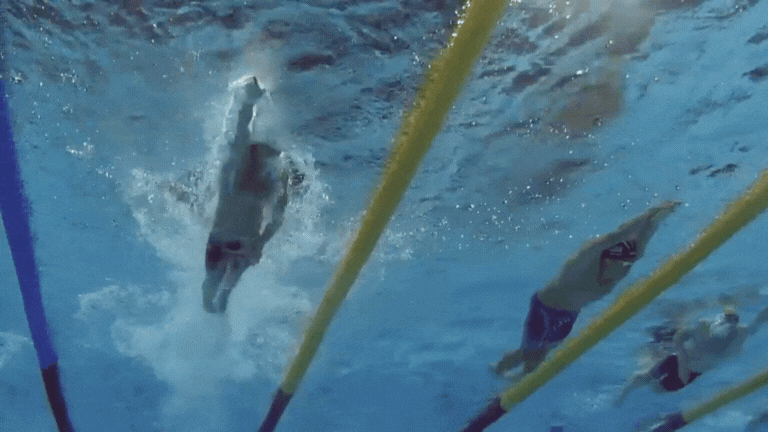
Mainly because flutter kicking is slower than dolphin kicking (Yamakawa et al., 2025). Freestyle kicking too early in the breakout pumps the brakes on the speed we’ve carefully generated through the dive, glide, and thunderous dolphin kicks.
Additionally, the dolphin kick has a larger range of motion and fires more muscle, which would conceivably give swimmers increased power and thrust during their first strokes of surface swimming.
Swimmers can work this type of breakout by doing freestyle arms with butterfly kick to get a sense of how the timing works with that first stroke cycle and final dolphin kick.
Kick using different body positions
Bob Bowman, Michael Phelps’ longtime coach, emphasized the importance of using a variety of dolphin kick body positions to improve technique and conditioning.
Different orientations challenge the kick in unique ways and help swimmers develop a more complete UDK skill set.
- Fish kicking (on your side) enhances undulation, improves symmetry between kicks, and increases body awareness.
- Vertical kicking isolates the legs, builds power, and reinforces core-driven movement.
- Rockets(pushing off the bottom and exploding upward) improve kick frequency and body control while simulating the forceful motion of a breakout.
- Dorsal kicking (on your back) opens up the hip flexors and encourages a smoother undulation movement that can be transferred to prone kicking.
Mixing up how and where you kick allows you the opportunity to attack areas of improvement from different angles and keeps training mentally fresh.
“A variety of movements will help you zero in on what your specific technique should be,” says Bowman.
The Bottom Line
Michael Phelps had a ton of natural talent and the physical characteristics for a fast dolphin kick (size fourteen feet, hyperextending knees, natural mobility). But that legendary kick wasn’t just natural talent, but a ton of hard work in training.
With progression, attention to technique, and a relentless work ethic, he turned his underwaters that could break the will of the competition and win races.
Learn from the GOAT, whether it’s fine-tuning undulation or developing power with vertical kicking or mastering a cleaner breakout, and watch your personal best times tremble before you.
If you’re frustrated with a sluggish dolphin kicking, clunky undulation, and not knowing what drills actually work, it’s time to upgrade your UDK.
The Dolphin Kick Manual is the ultimate step-by-step guide to building a faster, more powerful underwater dolphin kick.
No more guesswork. No more kicking like a manatee. Just proven strategies that work. Learn more below.
The Ultimate Guide for a Faster Underwater Dolphin Kick
Want help leveling up your underwater dolphin kick? The Dolphin Kick Manual is the ultimate resource for helping swimmers and swim coaches develop a world-class underwater dolphin kick.

The Dolphin Kick Manual is a beastly 240+ pages of actionable insights and research into elite dolphin kicking technique and performance. It details everything from mastering undulation to vortex recapturing to structuring a dryland program for dolphin kicking success.
It combines evidence-based insights with a collection of 20 ready-to-go sets and a 6-week Action Plan to help swimmers set a course for dolphin kicking success.
Train smarter and kick faster.

